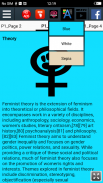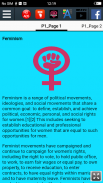








History of feminism

History of feminism介绍
The history of feminism is the chronological narrative of the movements and ideologies aimed at equal rights for women. While feminists around the world have differed in causes, goals, and intentions depending on time, culture, and country, most Western feminist historians assert that all movements that work to obtain women's rights should be considered feminist movements, even when they did not (or do not) apply the term to themselves.[1][2][3][4][5] Other historians limit the term to the modern feminist movement and its progeny, and instead use the label "protofeminist" to describe earlier movements.[6]
Modern Western feminist history is split into three time periods, or "waves", each with slightly different aims based on prior progress.[7][8] First-wave feminism of the 19th and early 20th centuries focuses on overturning legal inequalities, particularly women's suffrage. Second-wave feminism (1960s–1980s) broadened debate to include cultural inequalities, gender norms, and the role of women in society. Third-wave feminism (1990s–2000s) refers to diverse strains of feminist activity, seen as both a continuation of the second wave and a response to its perceived failures.[9] Although the waves construct has been commonly used to describe the history of feminism, the concept has also been criticized for ignoring and erasing the history between the "waves", by choosing to focus solely on a few famous figures, and popular events.[10]
女权主义的历史,是旨在为妇女平等权利的运动和意识形态的按时间顺序叙述。虽然世界各地的女权主义者的原因,目标和意图取决于时间,文化,全国各地都不同,大多数西方女权主义历史学家断言,这项工作取得妇女权利的所有动作应被视为女权运动,即使他们没有(或术语不)适用于自己。[1] [2] [3] [4] [5]其他历史学家限制用语对现代女权运动和它的后代,而是使用标签“protofeminist”来形容早期的运动。[6]
现代西方女性历史被分成三个时间段,或“波”,每个具有基于先前的进度稍微不同的目的。[7] [8] 19世纪和20世纪初的第一波女权主义侧重于倾覆法律的不平等,特别是妇女的参政权。第二波女性主义(1960 - 1980)扩大辩论,包括文化的不平等,社会性别规范,以及妇女在社会中的作用。第三波女性主义(1990-2000)是指女性主义活动的多样化的菌株,认为既是一个第二波的继续和其感知失败的响应。[9]虽然浪结构已经被广泛用来形容女性主义的历史,这一概念也被批评忽视和擦除“波”在历史上,通过选择只集中于几个著名人物和热门事件。[10 ]
























